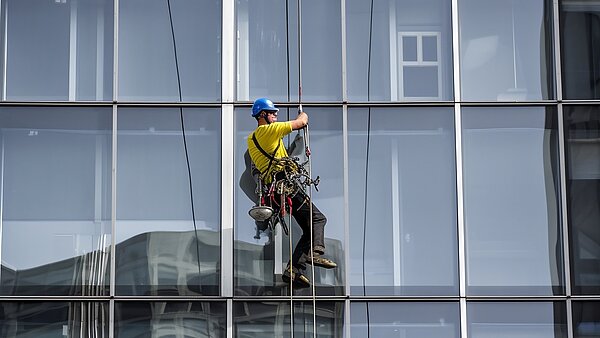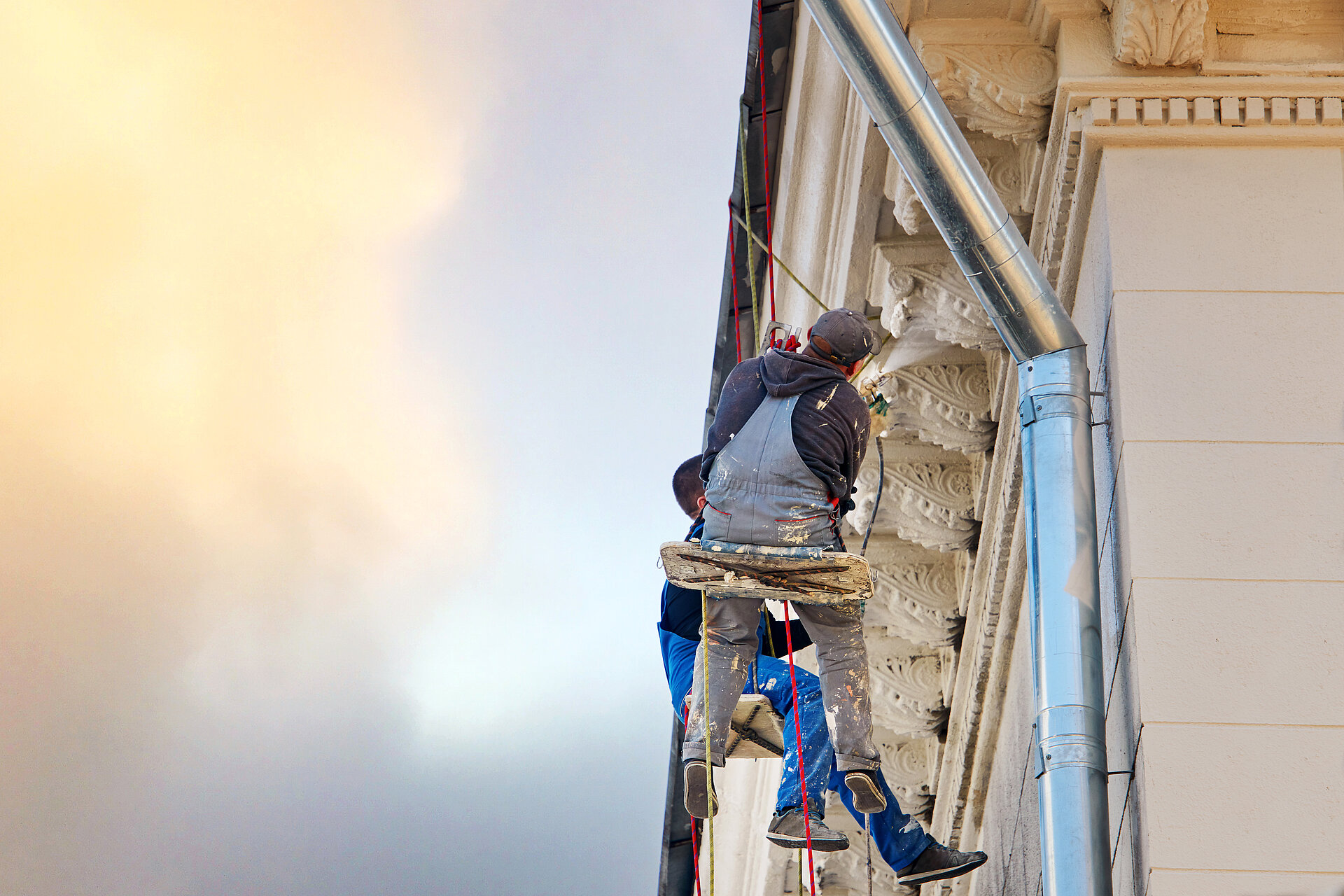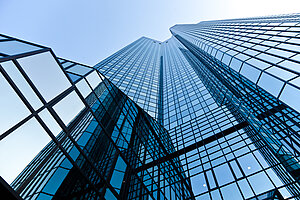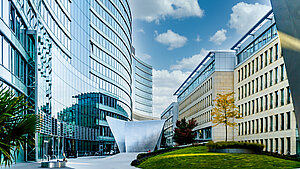Safe use of your fall protection system in every way – the (S)TOP principle
Regardless whether for the cleaning, repair, or maintenance of facades: the safety of all people involved takes top priority. For this, the (S)TOP principle represents the guidelines for working safely using fall protection and rope access technology. In addition to technical components such as equipment and the safety system, above all a sustainable safety concept includes personal, organisational, and behaviour-related measures.
The (S)TOP user principle
In the acronym “STOP”, the individual letters represent the following measures for safety at work:
- S for Substitution: Potential risks and dangers are eliminated even before the tasks start.
- T for Technical measures: Frequently, potential risks can be brought under control using technical measures. Depending on the facade type, measures such as railings, scaffolding, or working baskets (“facade maintenance systems”) reduce the state of risk for the users.
- O for Organisational measures: Safety by means of documented procedures within the organisation. For example, by limiting the number of people in the risk area, training measures, and emergency plans.
- P for Personal safety measures: Suitable equipment and appropriate training significantly reduce the risks during hazardous activities. Protection of the individual during the working day can be optimised through the use of PPE (personal protective equipment) and regular certified training (such as anti-fall PPE training and/or specialist training).
The inclusion of behaviour-related measures is a significant addition to the safety measures of the STOP approach.
- B for behaviour-related measures: Examples of these are safety-related training and a general sensitisation towards risks. They include the teaching of skills, and also further training measures, and encouragement of acceptance of the measures imposed.
For facades, a sustainable safety concept takes top priority – and not just because of the legal obligation. In additional to the general consciousness of the potential risks when working at height, the technical aspects are also of great importance. With the “(S)TOP principle”, organisational, personal, and behaviour-related measures also play an important role. Additionally, for all measures, the danger of the illusion of safety should never be overlooked: Failure to comply with the basic safety precautions because of measures which are incorrect, insufficient, or even completely absent are frequently the cause of fatal accidents. And it is also essential to comply with the sequence of the (S)TOP principle.
Risk assessment on facades
If damage to health may arise because of insufficient safety precautions, then this is called a risk. In contrast, a danger exist when there is an above-average likelihood of an industrial accident. A risk thus becomes a danger if it is not recognised or prevented. The objective of facade safety is to reduce the intrinsic dangers of working at height as much as possible , and to protect the people involved from accidents caused by falls. When working on facades, a risk assessment is required when the working height is greater than 2 metres. Depending on the facade type, the situations of risk must be identified and the resulting dangers must be minimised.
This risk assessment is performed in 7 steps:
- Recording of working areas and activities:
Fall protection experts define the risk area and the activities to be performed there.
- Determination of risks:
The areas to be protected are assessed, and the potential risks are determined. This provides the first indications of the safety equipment to be considered.
- Assessment of the risk:
The risks identified in the individual areas are analysed, and the learnings feed into the comprehensive safety concept. For the experts, this creates the basis for selecting a suitable safety system.
- Determination of the safety measures:
The appropriate safety measures are determined on the basis of the actual risks. Both technical and organisational measures are included. The (S)TOP principle plays a decisive role in this.
- Implementation of measures:
At INNOTECH an expert customer adviser is available as a contact partner throughout the whole implementation phase. This very significantly reduces the process of purchasing, installation, and training.
- Review of effectiveness:
During the installation, all the safety system’s parts, fastenings, and anchor points are thoroughly tested by the fitter responsible. In a concluding step before the acceptance of the facade safety system, the entire system is once again tested for effectiveness and practical suitability.
- Generation and updating of documentation:
Finally, the risk assessment is documented by means of photos and descriptions. By means of digital checklists, the INNO|doc documentation software creates compliance with the legal documentation obligations. In turn, clean and complete documentation is a prerequisite for the mandatory annual inspection of the fall protection system.
Fall protection on facades – and what does it cost?
As everyone knows: retrospective installations and modifications can cost an enormous amount. It’s no different for rope access technology. However, if it is already recognised at the planning stage, then significant cost savings are possible. But which costs actually arise for a fall protection system? An overview:
- Planning:
As a rule, the preparatory planning costs, such as the testing of the substructure, the risk assessment, and the development of the safety system are already included in the costs of the overall solution. The components of the facade safety system are generally standard parts which can be combined in modular fashion. Additional costs can arise when special designs are developed or have to be specifically manufactured.
- Material:
The material costs depend on the components actually used for the facade safety system. For all the components which we use, such as rail systems, fastenings, etc., we rely on certified products. These pay for themselves in a short time, because the costs of repairs arising from the annual inspection remain at a modest level.
- Installation:
As a rule, the inclusive price covers installation costs, working time, and travel expenses. It is possible for the customer himself to install some parts, but others must be installed only by a certified fitter.
- Documentation:
Documentation of the fall protection system is a legal requirement. This made easier through the use of our in-house INNO|doc documentation software. The next best thing: it’s free of charge.
- Certifications/approvals:
In the rare case that specially manufactured components are used, they must be specifically certified or approved before use. This can create additional costs.
- Servicing:
The inspections required by law create the costs of the certified inspector. He must inspect the equipment and documentation at least once per year.
3 tips for saving costs:
- From the very start, include the facade safety system in the planning: The later this is done, the more expensive the facade safety system can become, because delayed planning often makes modifications necessary which would otherwise have been avoidable.
- Develop the safety concept in collaboration with experts: A facade safety system cannot just be installed haphazardly. Even at the planning stage our experts can provide valuable input.
- Bring an experienced partner on board early on: Costly planning mistakes can be avoided when all the specialists sit together around one table. In the long term, our customers benefit from a well thought-out and professional fall protection system.
When a new facade fall protection system is installed, the principal costs arise in the areas of planning, material, installation, and documentation. They are affected by a number of factors which may significantly differ from building to building. On top of these come the costs of approving the system. But the regular servicing and inspection of the safety system must also be taken into account when calculating costs. Planning at an early stage, in collaboration with an expert partner, is the most important prerequisite for an effective and professional facade safety system.
The right tendering process: Professional tips on tendering for the optimum facade safety system
Even for many architects and consulting engineers, facade safety is unknown territory. It is therefore often neglected, even for large construction projects. Definitions and descriptions of requirements are deficient, and details and specifications are inadequate. However, an exact performance specification during the tendering process is decisive for the quality of the facade safety system. The outcome: Significantly excessive costs. We show you how to avoid mistakes and thereby make huge savings.
Tip from the experts: Even as early as the performance specification phase, benefit from the experience of our customer advisers at INNOTECH Arbeitsschutz, and avoid expensive beginners’ mistakes.
The big hurdle when writing tendering documents for a facade safety system: the performance specification. Within your working groups, clarify the following items in advance, and create a description of your requirements which is as detailed as possible. Depending on the building, your performance specification will be between 1 and 20 pages long.
- Area of application: How does the risk area look, and where will a fall protection system be required on the facade?
- Function: Which activities are to be performed on the facade? The requirements to be satisfied by the safety system derive from this.
- Facade: What type of facade are we dealing with? What are the characteristics of the substructure, and what fastening options result from this?
- System description: Which system are you considering? For example, the TAURUS rail system with or without the process of rope access technology? What do you expect from this system, and does it really provide the best all-round protection?
- Fastening and material specifications: If already known: are the planned substructure fastenings and products suitable for the intended system?
- Investment & installation costs: Breakdown of the individual costs – is it a calculation based on actual costs or an overall solution with a package price?
3 Professional tips when tendering your facade safety system
- Obtain a clear picture of the customer’s requirements and expectations:
Does the customer already have clear expectations, or is he completely ignorant of the challenges in terms of facade safety? The more detailed the customer’s knowledge, the better will he formulate his requirements. Don’t relax until it is clear to you in detail what the customer expects – and what he doesn’t!
- Plan facade safety early on and bring a strong partner on board:
No-one knows everything – so benefit from the experience of an expert in facade safety. He can also help to adapt the customer’s planning output and wishes to the building regulations. This creates the basis for deriving the requirements and technical feasibility at an early stage of planning. In this way, errors can be avoided right from the start, and a great deal of money can be saved on the bottom line!
- Use lists of specifications:
Breaking specifications down into functional blocks simplifies transparency. If necessary, supplement the individual items with additional information about special requirements, such as colour requirements for a hidden fall protection system.
Anticipatory and timely planning protects against unpleasant cost surprises. This is where an experienced partner helps in specifying the requirements for the facade safety system and also in keeping the project on track in terms of technology. You will find an initial overview in our White Paper. Download for free!
Plan B: What to do if the fall protection system was overlooked?
Better late than never: if the ultimate catastrophe has really occurred, and it turns out that the planning of a fall protection system has been completely overlooked, then the fat is in the fire. Not only nerves and money, but also the safety of workers can be at stake. And we haven’t even talked about loss of reputation yet. In any case, having an emergency plan up your sleeve for this situation is beneficial, in order to react purposefully and rationally.
Checklist of immediate measures:
- Include all decision makers, and convene a crisis meeting.
- Present the situation clearly and in full.
- Evaluate whether a temporary construction freeze could reduce costs.
- Consult a fall protection specialist, and explain the potential scenarios.
- Find a solution together.
In this situation, the most important thing is certainly to slow things down: Transparency, not covering up, is required in order to limit the damage. In crisis mode, the first step must therefore be to inform all parties who are significantly involved. In the subsequent crisis meeting, a temporary construction freeze certainly needs to be discussed. By this time at the latest, an experienced fall protection expert should be consulted. After the expert has viewed the plans and assessed the current state, including an onsite inspection, the next steps can be planned jointly with the project partners.
If the facade safety system was overlooked: the next steps
- Prepare documentation
A system which uses certified products and can be approved is drafted on the basis of the construction plans.
- Fulfilling official requirements
Compliance with legal requirements must be ensured – in the first place the retrospective system has to be approved.
- Keep an eye on additional costs
A fall protection system which has been overlooked will cost a lot. Create a cost overview, and price the scenarios for a threatened construction freeze. Check deadlines – because construction delays can bring painful penalties.
- Revise schedules
The emergency will make a mockery of your schedule. Make reasonable assumptions about delays caused by the emergency concept. Include buffer times in your schedule!
- Inform those involved
You are not going to escape the walk of shame. Inform all parties involved, including the subcontractors.
We all make mistakes. If the fall protection system really has been overlooked, there is still a fair chance of making good the oversight at an acceptable cost. With a reliable partner like INNOTECH at your side, and complete transparency with respect to the project partners, even this unfortunate situation can be overcome.
Best practice: ÖAMTC and University of Wuppertal count on INNOTECH
Discover two outstanding best practice examples of successful facade safety systems:
1. Best practice: Facade safety system at the ÖAMTC(Austrian Automobile, Motorcycle and Touring Club) headquarters
By tradition, safety is high on the list at ÖAMTC – and now so is facade safety. The ÖAMTC headquarters are architecturally spectacular – and the concept of its facade safety systems is equally sophisticated. Not least because of this, the safety concept was assigned to INNOTECH. The INNOTECH range fulfilled all the project’s requirements when equipping the building with state-of-the-art safety systems.
- Glass facade
The building’s ground plan indicates a five-finger form, and this creates numerous internal courtyards, whose facades were each equipped with a TAURUS rail system. This enables trouble-free servicing and cleaning of the complex glass facades. Providing maximum freedom of movement together with the greatest possible safety made the TAURUS system the ideal choice.
- Heliport
The helicopter landing space was provided collective fall protection, by implementing the BARRIER guardrail system. This provides optimum protection to people present in the heliport/hangar area. The collective protection also prevents an unintended approach to the fall edges.
- Wave
The external facade was built as a sloping roof which falls away towards the inside. The various curve patterns require differing safety concepts. The AIO lifeline system was installed here. Connections to posts(STA-10-500) and anchorage eyes(EAP-ABP-10-30)ensure secure anchoring; this enables flexible and safe working at every point on the external facade.
There are also sophisticated facade constructions indoors. Safe access to all parts of these elements is now also possible, thanks to INNOTECH systems. The internal LED facade as well as the glass facade elements were made safe using the TAURUS rail system.
2. Best practice: Fall protection system for the University of Wuppertal
At the University of Wuppertal, for the renovation of the glass curtain facades and the concrete curtain facades, a fall protection system was installed which allows them to be cleaned safely. This task too proved to be extremely demanding technically, and required a combined special solution of rail and cable systems. For one thing, the partially damaged substructure represented a significant technical challenge in terms of anchoring the posts of the TAURUS rail system, and in addition it was not possible to put load onto the concrete facade of the library tower.
For both problems, INNOTECH’s technical expertise created appropriate solutions. Not only is cleaning in safety now possible, but inspection is simplified, and even individual facade elements can be replaced. It was possible to attach the TAURUS rail system in such a way that it has become almost invisible in the overall structure of the glass facade. A further problem was solved by means of the AIO lifeline system: a special construction now provides continuous safety without attaching/detaching. This alleviated the dangerous situations on the servicing balconies. The users are now able to transfer their attachment from the lifeline system directly to the rail system.
Summary: Safe and stylish fall protection on facades
Every year, hundreds of people suffer accidents on roofs, facades, and other workplaces at height. The shockingly high number of such accidents could be reduced if suitable fall protection systems were in use. However, at the same time the facade safety system should not detract from the beauty of the building, because every structure has its own aesthetic value. For many years INNOTECH has been involved in developing the standards for high-quality fall protection systems, and has jointly designed facades which are both safe and aesthetically pleasing.
Still want to know more about fall protection systems on facades? Then download our free White Paper.






















